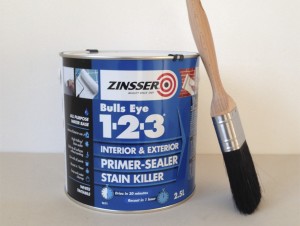Zinsser 123
Zinsser 123, or Zinsser Bulls Eye 1-2-3 to give it its full name, is a type of primer sealer that can help with all manner of DIY decorating jobs in your home. It’s slightly different in composition to my normal ‘go-to’ primer, Zinsser BIN, and in the guide below, I’ll explain why Zinsser 123 is sometimes the best choice when priming and sealing surfaces prior to decoration.
Zinsser 123 uses

Zinsser Bulls Eye 1-2-3 does what it says on the tin…….well nearly, in my opinion!
Well if you read the side of the tin, Zinsser 123 claims to prime just about any surface, including ceramic tiles, aluminium, stainless steel, vinyl, melamine, plastic, wood, masonry…..and the list goes on.
Crucially, it is also a stain blocker, so grease spots, graffiti, and damp stains are further additions to the list of problems that 123 can seal.
Because it dries very quickly, typically in 30 minutes, means you can get on with your top coats in the same day.
Painting with 123
Zinsser 123 is water-based, and so it’s a pretty user-friendly product. In other words, it doesn’t produce overpowering fumes as it has a low VOC content.
It’s easy to apply with brush and/or roller and goes on much like a mid sheen emulsion paint, drying quickly in readiness for your top coats of paint. Clean up after work is simple because 123 is water-based.
Zinsser 123 limitations
The problem I find with Zinsser 123 is that although it does pretty much everything it says on the tin, in some cases, it doesn’t do it quite as well as Zinsser BIN. Here are a few examples:-
1. When priming a melamine shelf surface, I find that Zinsser BIN provides a very tough base coat that is less likely to chip than is the case with Zinsser 123.
2. For stubborn grease marks on a wall surface, BIN nearly always blocks out the mark, but with Zinsser 123, the mark can sometimes bleed back through subsequent paint layers.
3. With damp staining, the same as point 2 above really – you sometimes get a bit of bleed back through the finish, so BIN can be a better option.
When do I use Zinsser 123?
I find 123 is an excellent base coat when, as examples, re-decorating bathroom ceilings that may have been subject to condensation/mould problems, kitchen ceilings where cooking fumes have caused some staining, and living rooms where an open fire has caused some soot staining of the ceiling. Remember that before applying 123, you still need to clean down as best is possible in order to provide as sound a surface as you can.
In all the above cases, using the solvent-based Zinsser BIN is not really an option as it is incredibly difficult to apply evenly on large open surface areas, because it dries so quickly. The smell of BIN is also pretty hideous, so again, never ideal for large areas.Â
So if you’ve got a wall or ceiling that needs priming, sealing, or a general stain blocking, I’d thoroughly recommend giving Zinsser 123 a go. With any small areas where stains still bleed through, you can still patch prime these with some Zinsser BIN before overcoating. You tend not to find Zinsser 123 in most of the DIY outlets, so take a trip down to your local decorating merchant, or you can always order it through Amazon.

I used Zinsser 1-2-3 to prime textured wallpaper (the kind made for painting) and an artex textured ceiling that had been painted with silk/vinyl emulsion. When we first purchased our home – a major fixer upper – I’d put a quick coat of vinyl on the room just so it was liveable. Four years and many, many major restoration jobs later, I got around to properly redoing the room.
I redid the room with matt emulsion and used the Zinsser to avoid any issues of the new paint cracking and not sticking to the old vinyl emulsion. If only I’d not painted the room with vinyl – but hindsight is 20/20 and at the time I was short on time and money.
The Zinsser went on great but it was quite a job to put it on using a brush. I did this as it is a very sticky product that I did end up watering down a bit as the job went on. I don’t think it would’ve been possible to apply it with a roller, especially since I needed to get it into all of the crevices and such on the surfaces.
The matt emulsion went on well. I used two coats and applied it as thinly as possible. I did have some minor issues of cracking in between the textures of the wallpaper, but the use of the Zinsser primer was definitely an absolute necessity. Minor touch ups of the cracked areas worked, and I really endeavoured not to put too much paint on the surface.